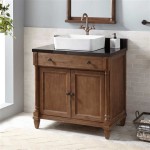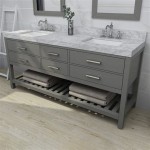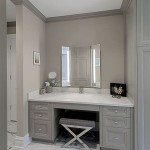Build Your Own Bathroom Vanity Kits
A bathroom vanity is a crucial component of any modern bathroom, providing both storage and style. While pre-made vanities are available in a wide range of styles and sizes, building your own vanity kit allows for greater customization and flexibility. Here's a comprehensive guide to help you create your own unique bathroom vanity kit.
Materials and Tools
Before embarking on this project, it's essential to gather the necessary materials and tools. These include:
- Vanity cabinet (choose a size and style that suits your bathroom)
- Vanity top (can be made of granite, quartz, marble, or solid surface materials)
- Vanity sink(s) (select the number and type of sinks based on your preferences)
- Vanity faucet(s) (complement the style of your vanity)
- Hardware (handles, knobs, pulls)
- Vanity lighting (optional, but adds illumination and style)
- Level, measuring tape, pencil
- Screwdriver, wrench, drill
Step 1: Assemble the Vanity Cabinet
Begin by assembling the vanity cabinet according to the manufacturer's instructions. Typically, this involves attaching the sides, back, and bottom of the cabinet, as well as installing the doors or drawers.
Step 2: Install the Vanity Top
Next, place the vanity top onto the cabinet and center it. Use a level to ensure it's level in all directions. Secure the top to the cabinet using screws or bolts.
Step 3: Install the Vanity Sink(s)
Position the sink(s) on the vanity top and mark the locations where the holes need to be drilled. Use a drill bit slightly smaller than the diameter of the sink drain holes to drill pilot holes. Apply plumber's putty around the rim of the sink and insert it into the holes, tightening the mounting hardware.
Step 4: Install the Vanity Faucet(s)
Locate the pre-drilled holes on the vanity top for the faucet(s). Apply plumber's tape to the threads of the faucet base and carefully screw it into the holes. Tighten the nuts underneath the vanity to secure the faucet.
Step 5: Install the Hardware
Attach the handles, knobs, or pulls to the doors or drawers of the vanity cabinet. Use a screwdriver to tighten the screws.
Step 6: Install the Vanity Lighting (Optional)
If desired, install vanity lighting above or around the mirror. Follow the manufacturer's instructions for wiring and mounting the lighting fixtures.
Step 7: Final Touches
Once all the components are assembled, check for any loose connections or leaks. Make any necessary adjustments to ensure everything is secure and functioning correctly. Clean up any residual debris and admire your newly built bathroom vanity kit.
Benefits of Building Your Own Vanity Kit
Building your own bathroom vanity kit offers several advantages:
- Customization: Tailoring the vanity to your unique bathroom design and preferences.
- Cost savings: Purchasing individual components can be more cost-effective than buying a pre-made vanity.
- Quality control: Selecting high-quality materials and assembling the vanity yourself ensures durability and longevity.
- Project satisfaction: The sense of accomplishment and pride in creating your own bathroom fixture.

How To Build A 60 Diy Bathroom Vanity From Scratch
:max_bytes(150000):strip_icc()/handmade-bath-vanity-5944157f3df78c537bc57584.jpg?strip=all)
16 Diy Bathroom Vanity Plans You Can Build Today

How To Build Your Own Bathroom Vanity Fine Homebuilding

Diy Bathroom Vanity

Diy Bathroom Vanity
:max_bytes(150000):strip_icc()/build-something-diy-vanity-594402125f9b58d58ae21158.jpg?strip=all)
16 Diy Bathroom Vanity Plans You Can Build Today

How To Build A Diy Bathroom Vanity Angela Marie Made

10 Diy Bathroom Vanity Ideas The Family Handyman

Ready To Assemble Bathroom Vanities Cabinets The Rta

How To Build A Diy Bathroom Vanity Angela Marie Made







